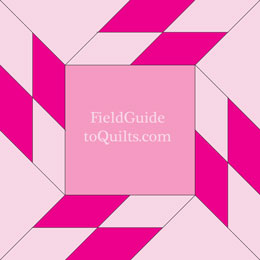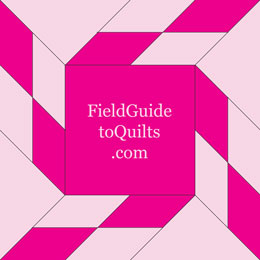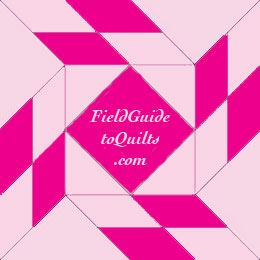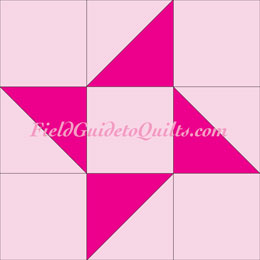| FieldGuidetoQuilts.com |
 Center-square pinwheels Center-square pinwheels
|
Click on an icon to go directly to the block you're interested in.
See also:
 Twin Sisters
Twin Sisters Arrowhead Puzzle
Arrowhead PuzzleAunt Martha
Windmill
















Windmill (Aunt Martha)
 Windmill
WindmillAunt Martha, 1954
Double Windmill
 Double Windmill
Double Windmill
 Double Windmill
Double WindmillCabot, 1938
 Sky Rockets
Sky RocketsDouble Windmill is a more ambitious, three-color version of Windmill from the Chicago Tribune (1938). Nancy Cabot was its designer. Nancy Page, a designer from the Birmingham News, called it Sky Rockets a few years later.
Slashed Album
























 Slashed Album
Slashed Album Slashed Album
Slashed AlbumLadies Art Co., #37 Two-color
























 Slashed Album
(three colors)
Slashed Album
(three colors)















Slashed Album (three colors)
 Slashed Album
Slashed AlbumThree-color
 Slashed Album
Slashed AlbumThree-color
The two-color edition, which is what the LAC published, winds up looking like a mass of alternating rows of four diamonds.
It is entirely unlike the effect of adding a third color.
Slashed Album could make a very pretty block with different fabrics for each diamond, but nobody except us has ever thought of that.
Flying Bats
















Flying Bats
 Flying Bats
Flying BatsFinley, 1929 A near twin to Slashed Album is the two color version called Flying Bats, captured by Ruth Finley in Old Patchwork Quilts (1929). It's based on an 8x8 grid.
We imagine that a cloud of flying bats would look exactly like this if it was heading towards us, but it would also be spinning.
If you're looking for the star block called Flying Bat, click here:
Flying Bats (Wheeler)
























 Flying Bats in three colors
Flying Bats in three colors Flying Bats
Flying BatsWheeler, 1933
























 Flying BatsOpen Windows
Flying BatsOpen WindowsBy flipping and turning Slashed Album, the pseudonymous designer called Laura Wheeler added an on-point square to the center of Flying Bats and made it unique. The block was published in 1933 in the Cincinnati Enquirer. We don't know where the colors were placed.
Nancy Cabot called it Open Windows. (Presumably, if you have open windows, you will soon have flying bats.) It was in the Chicago Tribune in 1937.
Friendship Star















 Friendship Star
Friendship Star
 Friendship Star
Friendship StarGutcheon, 1973 New Home/The Lost Goslin'/Wings in a Whirl/The Pin Wheel
Although it was published once as New Home in 1907 (Good Stories) and twice in the Kansas City Star (1939 and 1953), the name Gutcheon gave this block in The Perfect Patchwork Primer (1973) is the one that stuck.
Quartered Star















 Fort Sumpter/Fort Sumter
Fort Sumpter/Fort Sumter  Quartered Star
Quartered StarJames, 1978
We think Quartered Star looks terrific in our whole-quilt mockup.
Wheat Field
 Wheat Field
Wheat Field  Wheat Field
Wheat FieldMalone, 2003
Because of the arrangement of triangles, it may not look as if it's drawn on a 4 x 4 grid, but it is.
Box Quilt Pattern
 Alternative setting with offset blocks
Alternative setting with offset blocks Box Quilt Pattern
Box Quilt PatternLAC, #351
1897















Box Quilt Pattern
 Like so many other designs, this one was first printed in 1897 by the Ladies Art Company (#351). Designer Nancy Cabot named the design Box Car Patch in 1934, and the other names followed. The block is drawn on a 7x7 grid.
Like so many other designs, this one was first printed in 1897 by the Ladies Art Company (#351). Designer Nancy Cabot named the design Box Car Patch in 1934, and the other names followed. The block is drawn on a 7x7 grid.The name Contrary Husband comes from a 1938 Kansas City Star. Inevitably, a Contrary Wife block followed, in 1941. Contrary Wife usually goes by the name Double Hour Glass. You'll find it here:
Formal Garden
 Formal Garden
Formal Garden  Formal Garden
Formal GardenFarm Journal and Farmer's Wife Supplement, 1945
This block doesn't look as if it's drawn on a 3x3 grid, but it is. It was first published in 1945 in a magazine supplement from Farm Journal and Farmer's Wife, according to Jinny Beyer, who also lists the name Eccentric Star in her wonderful Quilter's Album of Patchwork Patterns.
As a whole quilt, the block creates a pinwheel pattern where the corners meet. On this site, we call a whirlwind. On this page, the whirlwind pattern appears in Box Quilt, Bacon Patch, Windmill, and Double Windmill.
Bacon Patch
















Bacon Patch
Cabot
Quilt historian Barbara Brackman attributes Bacon Patch to designer Nancy Cabot of the Chicago Tribune.
Churn Dash















 Churn Dash (Finley)
Churn Dash (Finley)  Churn Dash
Churn Dash Finley, 1929
Almost. Finley's block involves more time and less expertise. There are four identically colored squares in the center—a bit of extra sewing time — and all the squares are the same size.
Pin Wheel















 Pin Wheel
Pin Wheel Pin Wheel
Pin WheelFinley, 1929
Ruth Finley's Pin Wheel is a lot like her Churn Dash, but requires less work to achieve more style. Pin Wheel has only four half-square triangles, but it has three color values. Compared with Churn Dash, we imagine that Pin Wheel was the go-to sewing-practice block for the 19th century's coolest mommies.
The alternate names above are from the pseudonymous Laura Wheeler (two from 1933) Carrie Hall (1935), and Nancy Page (1938), according to Jinny Beyer's Quilter's Album (2009).
The Bat
















The Bat
 The Bat
The BatPrize Winning Designs
1931
The booklet Prize Winning Designs (1931), an Aunt Martha booklet (1933), and Nancy Cabot (1937) are all cited for this block; in 1940, The Progressive Farmer called it Blue Bell Block.





